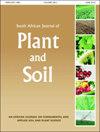石灰的形态、细度和放置对大麦和油菜生长发育的影响
IF 0.7
Q3 AGRONOMY
引用次数: 1
摘要
免耕制度和地表石灰缓慢移动会导致土壤酸度分层。遵循保护性农业做法的生产者不喜欢在耕作土壤中掺入石灰。在不干扰土壤的情况下促进石灰运动的方法研究有限。本研究旨在确定钙石灰的形态、细度和碳酸钙当量(CCE)对其在土壤中运动的影响,以及在不同土壤扰动作用下对大麦(Hordeum vulgare L.)和油菜(Brassica napus L.)生产力的影响。在南非西开普省进行了实地试验。10个处理包括对照、不同形式和细度的石灰和耕作方法。由于石灰在土壤中的缓慢运动和反应性,在石灰施用后的头两年内不太可能检测到大麦或油菜的生长反应。曾经的战略性耕作措施促进了作物生长。在对耕作的次生农艺反应中,这归因于土壤中石灰的再分配更深(15-30厘米深)。策略性的一次性耕作可以解决土壤酸度和营养物质(如钙和镁)的分层问题,可以作为一种选择纳入免耕生产系统的管理。本文章由计算机程序翻译,如有差异,请以英文原文为准。
Effects of form, fineness and placement of lime with and without soil tillage on barley and canola growth and development
No-tillage systems and slow movement of surface-applied limestone can lead to stratification of soil acidity. Incorporation of lime by tilling soil is not preferred by producers following conservation agriculture practices. There is limited research on ways to facilitate lime movement without soil disturbance. This study aimed to determine the effects of form, fineness and calcium carbonate equivalent (CCE) of calcitic lime on its movement in soil with or without different soil disturbance actions and consequent effects on productivity of barley (Hordeum vulgare L.) and canola (Brassica napus L.). A field trial was established in the Western Cape province, South Africa. Ten treatments included a control, lime with different forms and fineness, and tillage practices. Due to the slow movement and reactivity of lime in soil, it was unlikely that growth responses from barley or canola would be detected within the first two years following liming. A once-off strategic tillage action promoted crop growth. This was attributed to deeper redistribution of lime in the soil (15–30 cm depth), among secondary agronomic responses to tillage. Strategic once-off tillage may address the stratification of both soil acidity and nutrients, such as calcium (Ca) and magnesium (Mg), and could be considered as an option to incorporate into management of no-tillage production systems.
求助全文
通过发布文献求助,成功后即可免费获取论文全文。
去求助
来源期刊

South African Journal of Plant and Soil
Agricultural and Biological Sciences-Plant Science
CiteScore
1.90
自引率
11.10%
发文量
32
期刊介绍:
The Journal has a proud history of publishing quality papers in the fields of applied plant and soil sciences and has, since its inception, recorded a vast body of scientific information with particular reference to South Africa.
 求助内容:
求助内容: 应助结果提醒方式:
应助结果提醒方式:


